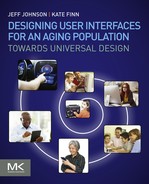Index
Accessibility guidelines, 5–7
Adjustable volume, 82–83
Adjust device output, 82–83
Age differences, 220–222
Ageing Education and Harmonisation Project, 6
Aging world, 2–3
Articulation, 80
other public transit systems, 193–194
personal navigation device screen, 197–198
phased and iterative approach, 194–196
web-based component, 196–197
Audible audio output, 80–81
Case studies
other public transit systems, 193–194
personal navigation device screen, 197–198
phased and iterative approach, 194–196
web-based component, 196–197
background, 183
card sorting icons, 184
current status, 187
evaluation, 184
formal usability evaluation, 185–187
hidden video control panel access, 185–187
prototyping, 184
redesign phase, 184
research phase, 184
COLABORAR user network, 188–189
contacts application, 189–191
current status, 192
look-and-feel, transformation of, 192
Center for Research and Education on Aging and Technology Enhancement (CREATE), 5
Cheat sheets, 127
Ciliary muscle, 28–29
Click target, 63–64
Cocktail party effect, 78
attentional blink, 95
burdening users memory, 105
change blindness, 95
cognitive interactions, 97–98
concise writing style, 108–109
consistency, 110–111
distractions, ability to ignore, 90–92
generalization between situations, 90
learning, 88–90
long-term memory storage and retrieval, 88–90
spatial memory, 93–94
memory
episodic memory, 89
long-term memory, 88–90
procedural memory, 89
prospective memory, 89
semantic memory, 89
short-term memory, 86–88
multitasking ability, 92
older adults, cognitive characteristics of, 85–98
processing speed, 95–97
CREATE (Center for Research and Education Technology Enhancement), 5
Digital immigrants, 19–21
Digital natives, 19–21
Double click, 68–69
background, 183
card sorting icons, 184
current status, 187
evaluation, 184
formal usability evaluation, 185–187
hidden video control panel access, 185–187
prototyping, 184
redesign phase, 184
research phase, 184
Exit strategy, 178–180
Fitts’ law, 57
Fovea, 29
Generation gap
birth generations, 19–20
digital immigrants, 19–21
digital natives, 19–21
technology generations, 21–22
Gen X, 19
Gen Y, 19
Gen Z, 19
Glaucoma, 31
COLABORAR user network, 188–189
contacts application, 189–191
current status, 192
look-and-feel, transformation of, 192
Hand-eye coordination, 56–58
age-related changes, 73–79
fast speech, understanding, 79
filtering out background noise, 78–79
high-frequency sounds, 76–77
localizing sounds, 77–78
low-volume sounds, 75–76
poor, 79
Horizontal scrolling, 52
Human visual acuity, 28
Information access, 156
Intelligence
digital technology gap in older adults, 120–127
Large fonts, 42–44
Localize sounds, 77–78
Long-term memory, 88–90
Low-volume sounds, 75–76
Macula, 31–32
Manual dexterity, 56
Memory, 86–90
fine motor control, 56
Fitts’ law, 57
hand–eye coordination, 56–58
manual dexterity, 56
movement, 59
older adults and, 56–62
Steering law, 57
strength and stamina, 61–62
variance in movements, 59–61
Multi-finger gestures, 69–70
Multiple age-related changes, 6
Older adults, general, 13–22
ability, 17
aptitude, 17
attitude, 17
characteristics, 17–22
defined, 13–14
digital device ownership, 18–19
generation gap, 19–22
naming, 14–15
offline, 17–18
online, 17–18
personas, 22–26
Presbycusis, 73–75
Short-term memory, 86–88
Smart data input, 147
Specialized search functions, 138–141
Specification prototype, 204
age-related changes, 79–80
Static text, 42–44
Steering law, 57
design decisions, 207–208
final remarks, 209
intuitive, 199
iterative process, 200–204
methodology, 199–200
recommendations, 208–209
testing, 205–207
Swipe target, 63
Tap target, 63–68
Technology generations, 21–22
UX framework, 206
Vertical scrolling, 52
central vision, 31–32
changes in brightness, adaptation to, 37–38
characteristics of vision in older adults, 28–42
colors, discrimination of, 33–36
contrast sensitivity, 33
eyestrain, 38
eyestrain, 38–39
farsightedness, 28–29
glare sensitivity, 37
light perception, 32–33
peripheral vision, 29–31
reading speed, 42
subtle indicators/distinctions, detection of, 38
visual acuity, 28
visual distractions, sensitivity to, 39–40
visual processing speed, 39–40
visual search, 40–41
Visual distractions sensitivity, 39–40
Visual language, 47–48
WAI (Web Accessibility Initiative), 6
WAI-AGE (Web Accessibility Initiative), 6
WHO (World Health Organization), 2
Working memory capacity, 86–88
behavior of older adults during design/usability evaluation, 161
data collection, 162
data evaluation, 162
older adults as participants in design and evaluation, 160–162
recruiting older adult participants, 161
self-presentation of older adults, 161
unfamiliarity of older adults with usability studies/participatory design, 160
World Health Organization (WHO), 2
..................Content has been hidden....................
You can't read the all page of ebook, please click here login for view all page.
